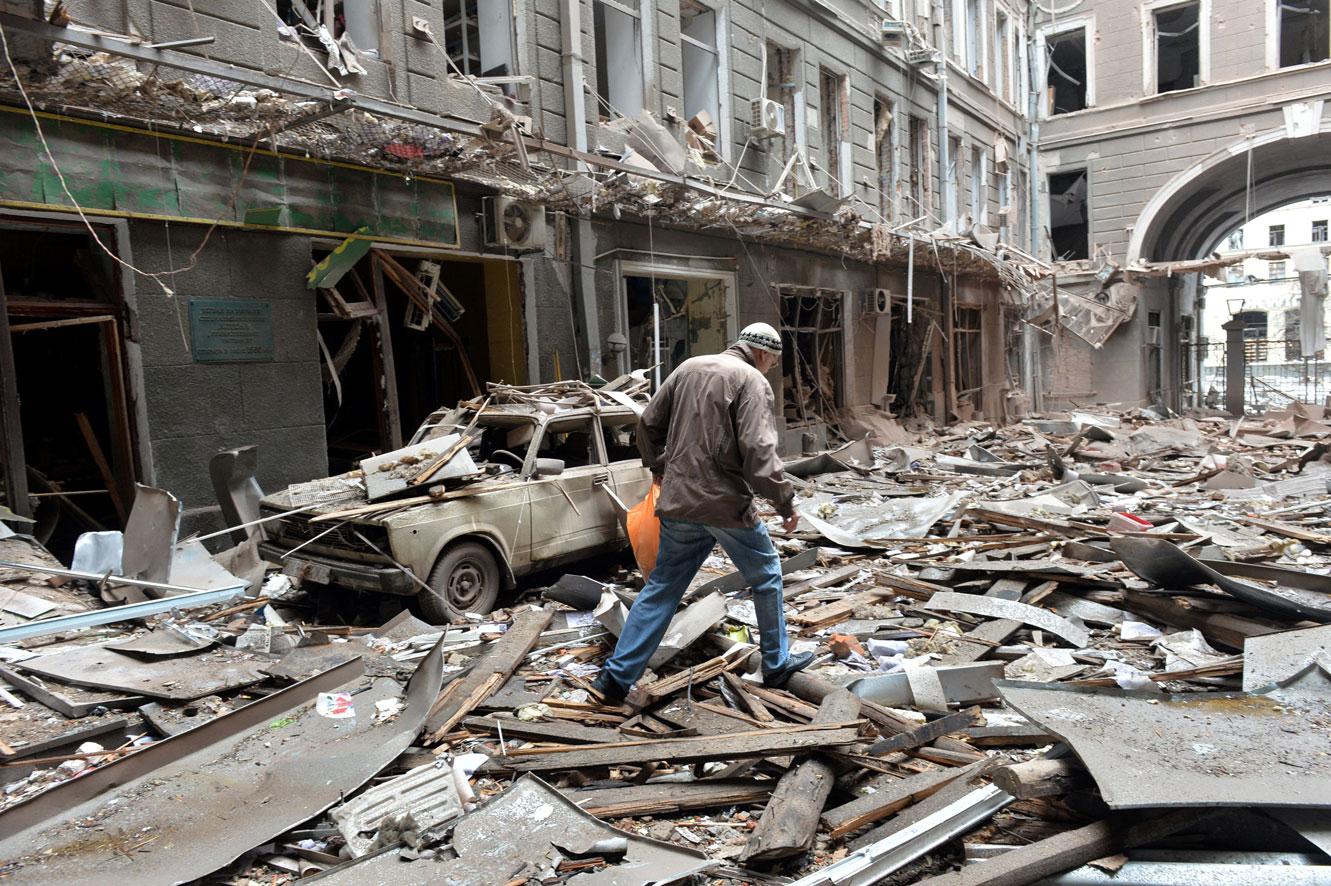Flowers bloom over an unmarked grave in Kharkiv. We never found the woman’s name, but the neighbors buried her in a shallow grave in the garden she had tended her whole life. Springtime has come to Ukraine’s biggest city, which has mostly been relieved of the agony of three months of Russian bombardment.
Galina, a 61-year-old teacher from Kharkiv, lived underground for nearly three months, but her daughter in Russia refused to believe that their city was being bombed. “You’re lying,” she told her mother over the phone from the safety of her house in the Urals, where she lives with her Russian husband. Galina had been living in her basement with her daughter-in-law and grandchildren for three weeks in a district directly on the front line. The area was contested between Russian and Ukrainian troops, so no aid could reach the shelter. And with no running water, they were forced to drink melted snow.
“When we were evacuated, I looked out the windows of the bus. I saw parts of destroyed vehicles and parts of dead human bodies,” she said before she broke down crying. “I’m sorry I can’t talk anymore about what I saw,” she said as one of the metro station’s volunteer staff put her arms around her. Galina then stared me in the eyes with a mix of tears and rage. “I can’t process how my daughter doesn’t even believe her own mother.”
Since Russia invaded in February, Ukraine’s second-largest city has survived a brutal and indiscriminate shell barrage unseen by a European city of its size since World War II. Now the city’s pain is finally easing. Ukrainian forces have been gradually retaking ground in Kharkiv oblast and have pushed most Russian artillery outside range of the city. The countryside is effectively one massive front line with both sides exchanging artillery fire over hundreds of square kilometers. The countryside is full of corpses, both men and metal. One local soldier explained that the Russians’ fatal flaw in packing their tanks was to place the ammunition high and near the driving compartment. When a Ukrainian shell hit them, it would ignite the ammunition around the soldiers, incinerating them and blowing the turret clean off the tank.
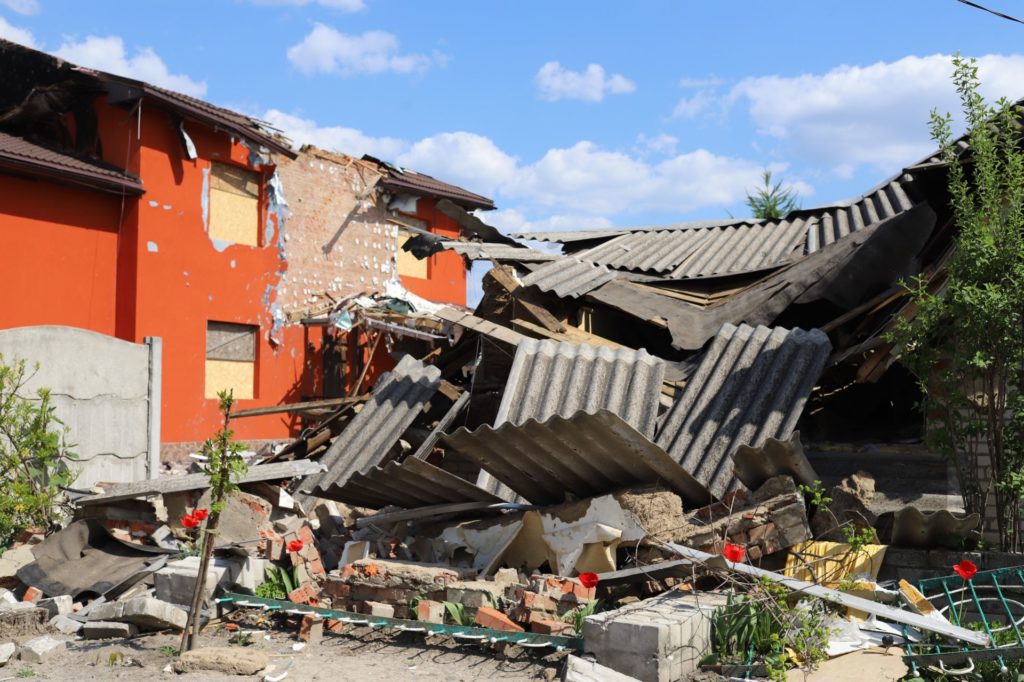
Galina was one of the thousands of people who lived in metro stations throughout Kharkiv. While authorities recently went about plans to reopen a substantial part of the metro network, thousands of people have been left homeless as a result of the bombardment and still rely on the stations for shelter. Others are afraid to emerge in case the Russian attack returns. They call themselves “passengers,” a nod not just to the normal use of the stations but also the hope that their stay below ground is temporary. Despite the desperate situation, Galina was incredibly grateful for the little she has. “Here we have everything we need. We have food, blankets and medicine. The staff are kind, and we are as safe as we can be.” She has now left to return with her pregnant daughter in law to her home village just in time for the birth of her grandchild.
She pointed to certain supplies such as canned tuna cottage cheese and fruit puree that were considered delicacies in her hometown. “We sometimes have even more than we had back home!”
Galina’s grandsons are also enjoying not having school or homework for now. But she worries about the future they will grow up in. When I was in Kyiv during the first week of the invasion, I spent several nights sleeping in one of these metro trains. Back then it was a free-for-all with no organization. It was old and young alike crammed in with everyone glued to their phones watching updates on the battles that were raging on in the outskirts of the city and in the skies.
Now Kharkiv, like Kyiv in April, is beginning to fill up with people who fled, and social and economic life is beginning to resume after months when Kharkivites lived underground. The Russians were unable to take Kharkiv after stiff Ukrainian resistance drove them back from the city during the first days of the war. It never saw a concerted assault like Kyiv or the Donbas. Instead, its fate has been in some ways crueler. It was subjected to an indiscriminate campaign of artillery shelling that left the city streets almost devoid of life.
New Lines visited two metro stations, one near the central district and another near Saltivka in the northeast of the city that was just 5 miles away from Russian lines. Extensive shelling has taken place around both of them. The conditions are squalid and depressing, with a dank, humid air that smells of body odor and is full of mosquitoes. Many people have bloodshot eyes or skin discoloration and, in some cases, visible sores.
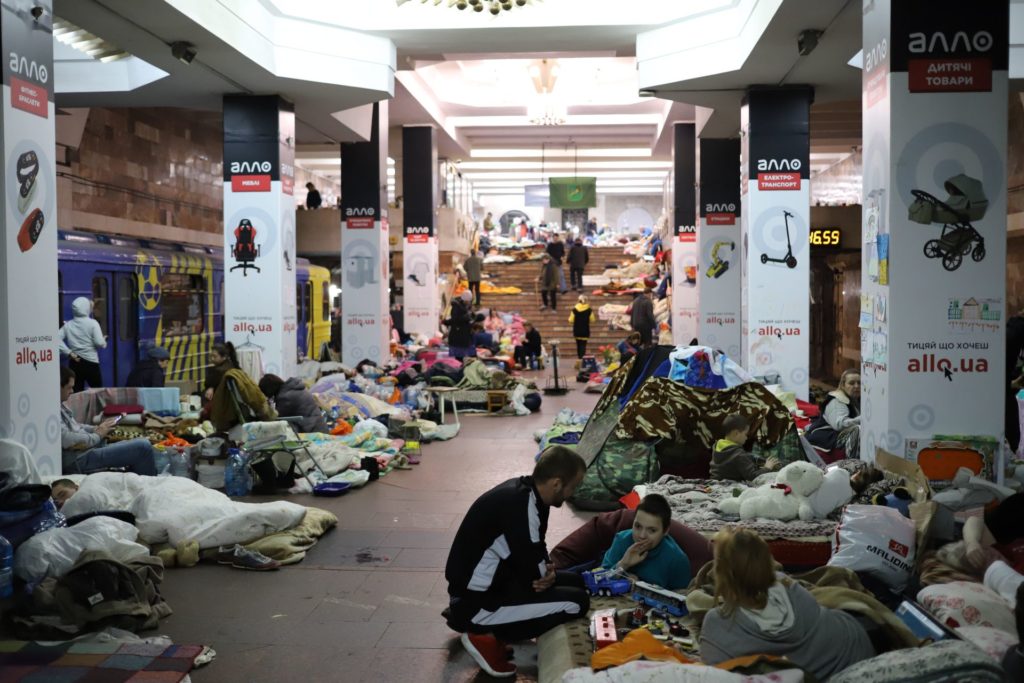
“When we worked here our guidelines were to never spend more than half a day underground because it could make you sick,” said Nastya, a 23-year-old former train attendant who now works as a volunteer organizer. “Now there are people who haven’t left in nearly two months, and it is impossible to keep them all healthy.”
First-class accommodation is a disused train carriage where the occupant can have a row of seats that doubles as a bed, a small measure of privacy and a dark space to sleep any time of the day. A few others brought their own tents to make bunk beds, but the vast majority lay on thin mattresses, sleeping bags or threadbare blankets on the cold stone floors. The passengers have little to do except read books and fiddle on their phones. There are a few activities organized for the children, including art therapy sessions. Sometimes the soldiers visit on their breaks from the frontlines to see family and to hand out sweets to the children. The volunteer staff take great care to keep their kitchens and medical facilities clean and sterile. There is a doctor on standby. While we were there, elderly residents were being treated for large blisters developed by staying in the same positions. The main supplies they need are essential medicines, especially antibiotics.
Officially everyone is equal, but an unofficial organizational hierarchy has sprung up, with several volunteers who have managerial experience directing the distribution of food and supplies. Olya, a 29-year-old trained psychologist who used to work as a CEO’s assistant, is one of these. She describes her role as just helping, but you can see from the way the passengers treat her and the number of phone calls she takes that people consider her the boss. It isn’t her first experience with war. “I am from Stakhanov in what is now the Luhansk People’s Republic,” she said. “I was there when the conflict in Donbas started eight years ago. I had been through the start of a war before, so I didn’t feel as shocked, and I knew what to do.”
Many of her former friends and family from her hometown have little sympathy for what the rest of Ukraine is going through. “This is what we’ve gone through for eight years,” they tell her. As a woman, she can leave Ukraine whenever she wants but says she needs to stay close to her family— even though they are indefinitely separated by some of the world’s most dangerous frontlines. “Besides,” she said, “I can’t just leave all these people here because they need our help.” She seems genuinely absorbed and energized by the responsibility here, although she admits that “every day or so I need to take five minutes to have a breakdown. Then I’ll shake myself off and get back to work.”
Now that the place is starting to clear out, there is delight but also confusion. “It is hard to believe that we can go back to our normal lives after only three months,” Olya said. “People are scared or anxious of what is going to happen next. Others say that we will stay at home again. Some people don’t know how to start their lives again. They keep asking me, ‘Are you sure it is safe and we can really go home?’”
None of the children we met were studying or receiving any form of education, but for their parents this was a minor concern. “We will catch up with them later,” said Natalia, a 37-year-old beautician with two daughters, Masha, 11, and Sasha, 15. The only time she and her two daughters leave is to take a short trip to their apartment to shower. Others leave less frequently if at all. When we took Galina upstairs to shoot her portrait, she couldn’t stop squinting. It was the first time in weeks she had been outside, and her eyes couldn’t adjust to sunlight.
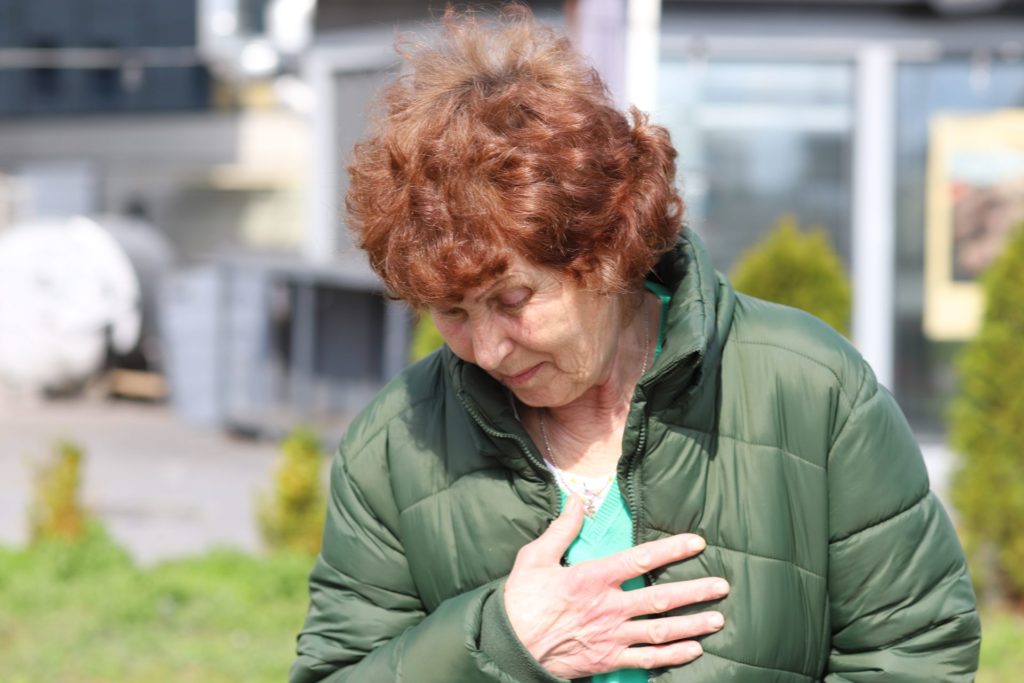
The leafy suburb of Danyliuk is adjacent to Saltivka and located right on the city limits of Kharkiv. The sunlight, spring blossoms and flowering of bright red tulips make for an eerie contrast to the destroyed houses and backyards with their caved-in roofs and collapsed fences. In one backyard the residents had buried a local woman who had died in an artillery attack. She lay in a grave marked with a simple wooden cross next to the blooming flower garden she had carefully tended to.
The reasons people choose to live in such wretched conditions can be easily seen with a short trip through the surrounding districts. As we left Heroiv Pratsi we met Sergey and Yevhen, a pair of volunteers who delivered food and humanitarian aid to the worst hit districts and offered to drive us around.
Sergey pointed out the town of Tsyrkuny, where the Russians had based much of their artillery since the start of the war. He reckoned Russian positions could be as close as 2 miles away. We could hear regular outgoing and incoming artillery fire although no shells hit the suburb while we visited. Ukrainian troops have since claimed to have recaptured the area around here. Residents said most of the damage had been done in the first weeks of the war. The few who remained were all elderly and infirm, with nowhere to go.
In a house slightly further down the road we met Alexei and his father Nikolay. They had been working in their garden when two rockets hit their living room, blowing it to bits. The roof had caved in, and it was covered in debris. But a bedroom and kitchen on each side of the living room somehow remained unscathed. So, the father and son chose to continue living in the wreckage of their house. They showed us bricks they had laid on one of the walls to begin the rebuilding process despite still being under siege. Like many in these areas, the pair live almost entirely without power or electricity and showed us the small outdoor stove that they rely on for cooking.
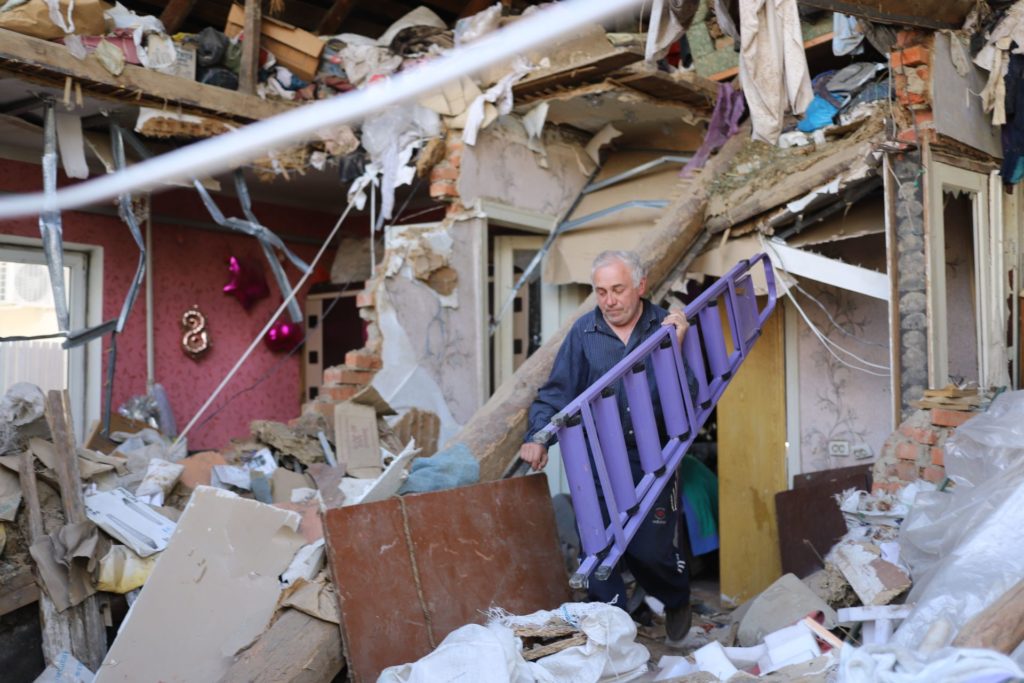
Like Galina and the others in the metro, Alexei and Nikolay were incredibly grateful, tearfully praising the bravery and selflessness of the volunteers they depended on. As one Kharkiv resident put it to me, “They say war brings out the best and worst in everybody who lives through it. We now know for sure who each kind of person here is.”
Despite being Ukraine’s second-largest city and a Russian-speaking one, Kharkiv has suffered more devastation than any other city, with the exception of Mariupol. As we passed burned home after burned home, Sergey would gesture out the window and say “Russkiy mir” (Russian world). It has become a regular phrase among residents, especially in southern and eastern Ukraine, who use it to mock Putin’s contention that these regions would prosper under Russian rule.
Some of the bombings were senseless even by Russian standards. When we returned from Saltivka, Russian troops had bombed a ride in Gorky Park: a long-abandoned children’s amusement park complete with roller coasters and a Ferris wheel. Every time journalists investigate these targets, the same pattern emerges: no evidence of military targets and a second follow-up strike in an attempt to hit the first responders or reporters who rushed to the scene. The endless bombardment seemed to be nothing but a punishment for rejecting the kind Russian offer to be part of the Russkiy mir. When we go upstairs out of the grim but safe confines of the stations, we remember just why. The day I visited I could hear shelling nearby. Colleagues of mine who returned the next day were nearly caught in the middle of an artillery barrage. The closest shell landed just over 100 yards away, and they were forced to race down the stairs of the metro station for shelter. Contrary to the Ukrainian army’s expectations the Russians still maintain a few artillery positions capable of reaching Kharkiv. Just yesterday the first shells hit Kharkiv in more than two weeks killing at least nine people.
While Olya is delighted about Ukraine’s successes, she is still deeply worried about the future of her country. Over the phone she says, “In a nutshell, on the one hand we are really happy that the Russians have been kicked out of Kharkiv, but on the other hand we see the map of where the Russian shelling has been happening in Ukraine right now and we see the war didn’t stop. It just moved to another part of Ukraine.”
Now it is the turn of the Donbas to feel Putin’s wrath.



